The fish collagen peptides market is estimated to be worth USD 855.8 million by 2025. It is anticipated to reach USD 1.35 billion by 2035, reflecting a CAGR of 4.7% over the assessment period 2025 to 2035.
The industry is making remarkable progress, primarily through the insistent consumer want for natural, bioavailable, and functional protein supplements. Since fish collagen peptides entirely obtained from marine sources, they are predominantly used in dietary supplements, cosmetics, functional foods, and pharmaceuticals because they are highly absorbent and have a lot of health benefits. The increased demand for joint support, skin health, and anti-aging products is the other factor that drives growth in the industry.
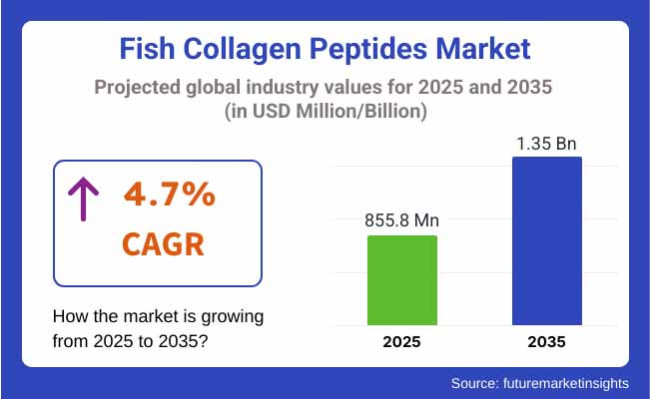
The main growth of the industry is a result of the increased knowledge that people have about the positive consequences of collagen, including its effects on skin elasticity, hair growth, and bone health. Fish collagen peptides are now the consumers' choice for a more natural and sustainable alternative to bovine and porcine collagen sources.
This is due to the high bioavailability of fish collagen peptides as well as the fact that they are compatible with pescatarians and the halal/kosher diet. Besides, the use of collagen as a nutrition supplement in sports and wellness is trending which is shifted the focus in the industry.
The functional food and beverage industry expansion in the industry is also a big part of this business development. Fish collagen peptides are incorporated in protein bars, beauty drinks, and fortified dairy products that are made for health-oriented people. The clean labels, non-GMO, and marine-sourced collagen demand are the main driving forces behind product innovations in this sector.
The purification, solubility, and efficiency of fish collagen peptides are being improved because of the new technology in collagen extraction, hydrolysis, and formulation. The adoption of good sustainable practices, such as the utilization of fish skin and scales, as waste generated by the seafood sector, are exercises in their own right on environmental problems and persuading a circular economy.
Nevertheless, the industry is also facing some difficulties such as time-dependent availability of raw materials, regulation of marine-derived ingredients, and competition from other protein and collagen sources. The consumer's price consciousness can also contribute to the failure to adopt the premium fish collagen products.
In spite of these challenges, the potential for industry expansion is humongous. The rising industry for marine-based nutraceuticals, basics like increasing research on collagen's gut health and immune benefits apart from the ones already discovered, opens many new paths.
Furthermore, the emergence of the direct-to-consumer brands and e-commerce platforms marks an improvement in the product's accessibility and recognition. Fish collagen peptides indeed are an industry that promises continuous development throughout the years as people prefer to get their beauty through inner wellness and holistic approaches.
The industry is witnessing robust growth as demand for natural, bioavailable, and sustainable protein sources is on the rise. The nutraceuticals and cosmetics sectors are the key drivers of growth, with consumers looking for anti-aging, skin health, and joint-support products.
In the pharmaceutical industry, fish collagen peptides are applied in wound healing, bone health, and medical supplements, with high-purity formulations being the priority. The food & beverage industry is adding collagen to functional foods, protein bars, and beauty drinks, which is increasing demand for odorless, tasteless, and easily digestible peptides.
Sustainability is an important driver in purchasing decisions, with marine collagen preferred over porcine or bovine collagen because of religious and ethical concerns. With increased consumer awareness, the industry is moving towards hydrolyzed, wild-caught, and GMO-free collagen products, driving innovation in the industry.
The following table compares the difference in CAGR for six months between the base year (2024) and the current year (2054) for the industry. This evaluation identifies significant changes in performance and reflects revenue realization trends, hence giving stakeholders an improved picture of the growth path throughout the year. The first half of the year, or H1, is between January and June. The second half, H2, comprises the period from July to December.
| Particular | Value CAGR |
|---|---|
| H1 | 3.5% (2024 to 2034) |
| H2 | 4.4% (2024 to 2034) |
| H1 | 4% (2025 to 2035) |
| H2 | 5.5% (2025 to 2035) |
In the initial half (H1) of the decade between 2025 and 2035, the company is expected to grow at a CAGR of 4%, followed by a higher growth rate of 5.5% during the second half (H2) of the same decade. Transferring to the next period, H1 2024 to H2 2034, the CAGR is anticipated to grow to 3.5% during the first half and remain quite high at 4.4% in the second half. During the first half (H1), the industry saw a growth of 12 BPS, whereas in the second half (H2), the company saw a drop of 8 BPS.
Throughout 2020 to 2024, the industry had witnessed phenomenal growth due to consumer trends towards increasing health-consciousness and concern towards the health and wellness benefits that collagen supplements offers. The COVID-19 pandemic has significantly boosted this trend, with preventive medicine and immune function having increased interest among consumers.
Fish collagen peptides became very popular at that point all over the world because they are highly bio available compared to the other collagens in the various industries like North America and Europe and also in the Asia pacific (with the exception of a few countries).
The "beauty-from-within" trend also genuinely helped, since it was a period when customers were looking for solutions for their skin hydration, elasticity, anti-aging, etc. In 2020 to 2025 the industry of fish collagen peptides will undergo gradual development on the wave of advances in biotechnology, the booming demands in individualized nutrition and the field of collagen application development.
As increasing scientific evidence becomes available for the physiological activity of fish collagen peptides, new opportunities are being established for future areas of development in psychological well partake, mental well-being, and metabolic well-being.
These innovations encompass nano-encapsulation and high-accuracy hydrolysis, which influence product function and facilitate sophisticated delivery systems such as transdermal patches and liquid delivery systems. During the decade, collagen peptides will boom in the sports nutrition industry as athletes and geriatric populations increasingly demand holistic musculoskeletal management.
Comparative Market Shift Analysis (2020 to 2024 vs. 2025 to 2035)
| 2020 to 2024 | 2025 to 2035 |
|---|---|
| Increasing demand for marine-based collagen in health and wellness, growing applications in beauty and nutraceuticals. | Increased advanced bioactive collagen formulations, increasing demand for precision nutrition, and growing use in medical applications. |
| Hydrolyzed fish collagen preference in powders, capsules, and functional beverages. | Movement towards customized collagen blends, improved absorption formulas, and vegan-collagen substitutes through bioengineering. |
| Enzymatically hydrolyzed peptides for improved absorption, flavored collagen beverages, and combination supplements. | AI-formulated collagen, nano-delivery systems of collagen, and medical food containing collagen. |
| Ethical wild-caught fisheries sourcing, reduction of waste from fisheries processing industries. | Zero-waste marine collagen harvesting, circular economy strategies, and carbon-neutral manufacturing. |
| Enhanced enzymatic hydrolysis technologies for bioavailability improvement. | Smart synthesis of collagen by precision fermentation and AI-optimized peptides. |
| Stricter labeling requirements and clean-label certifications gaining importance. | Tighter regulations on sourcing transparency, bioengineered collagen approvals, and health benefit claims verification. |
The fish collagen peptides industry is endangered by the harm chain risks caused by the high reliance on ocean resources. Fish stocks, climate changes, and very strict quotas that fishermen have to follow are some of the factors due to which the supply of the starting materials is affected and so is the price. Certification and traceability of the sourcing are important for producers to maintain the production line smoothly while at the same time addressing environmental issues and abiding by regulations.
Shifting consumer preferences cause demand differences in the industry. Consumers are generally much more attracted to collagen peptides in the fitness and beauty sectors, but competition from plant alternatives and the doubts about their effect can lower the sales. Companies must commit to scientific research, opt for transparent product labeling, and use targeted marketing to inform and educate consumers so that they can keep up the demand.
The price movements of the raw materials have a direct effect on the profitability of the companies. The seasonal rise and fall of the fish supply as well as the additional costs of running a sustainable fishery increase the cost instability. Manufacturers can overcome the cost problem by signing long-term agreements with suppliers and also by looking for cheap but effective processing techniques.
Industry penetration is a challenge ranging from differences in cultural dietary preferences to the limited consumer knowledge in some areas. Health and wellness companies embarking on new journeys have to come up with different promotional plans, highlighting the product advantages, and enter into alliances with health and wellness influencers to cause a ripple effect and get an industry share in the area.
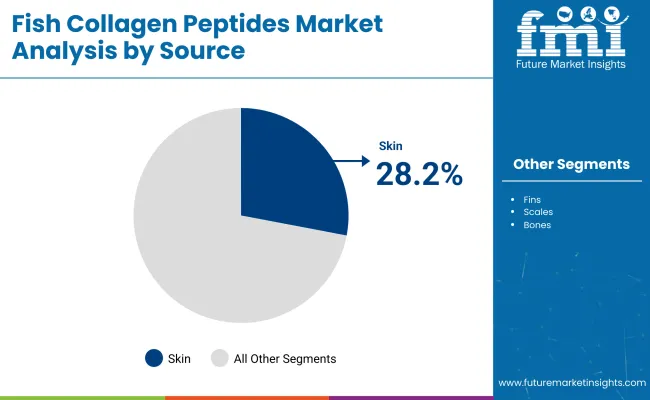
Growing Consumer Desire for Age-Defying Solutions Elevating the Skin Segment’s Market
| Segment | Value Share (2025) |
|---|---|
| Skin (By Source) | 28.2% |
The rising demand for nutrients and functional components in health, beauty, and pharmaceutical applications has propelled the growth of the industry. In 2025, the industry will be segmented by source, with a high proportion of the industry coming from fins and skin.
The main source of collagen peptides is fish fins, accounting for 30.5% of the industry share. They are viscous with Type I collagen, the richest collagen, recognized for its high bioavailability and benefits to skin, joint, and bone health. Fins are commercial sources of collagen peptides used in nutraceuticals, cosmetics, and functional foods.
Nonetheless, the superior purity, low molecular weight, and fast absorption characteristics of high-grade collagen peptides are under development to produce this by leading manufacturers such as Rousselot, Gelita, and Nitta Gelatin. Thanks to the popularity of marine-based clean-label supplements, fins-based collagen peptides are in high demand.
Fish skin-derived collagen peptides will dominate this industry segment, accounting for 28.2% by 2025. Type I collagen has demonstrated anti-aging, moisturizing, and skin-repairing properties, which is why it is found in many cosmetic and skin care products. However, it is costly and scarce, whereas fish skin-derived collagen is inexpensive and abundant.
Companies like Vital Proteins, PB Leiner, and Weishardt are focusing on marine collagen peptides derived from fish skin (as opposed to by-products) because they can offer a more sustainable, more traceable, and more functional protein. Younger consumers prefer sustainable and marine-origin collagen products; thus, this segment will provide lucrative growth opportunities in the coming years.
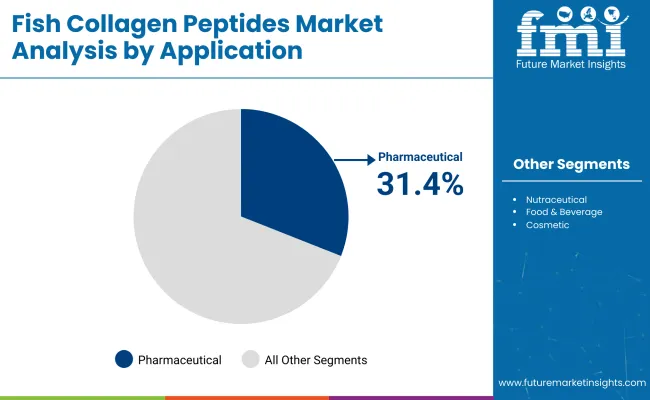
Increasing Demand for Bioactive Therapeutics Driving the Pharmaceuticals Segment’s Market
| Segment | Value Share (2025) |
|---|---|
| Pharmaceuticals (Application) | 31.4% |
The industry is segmented based on product type, application, and region. By application, the industry will be divided into pharmaceuticals and bone and joint health in 2025.
In 2025, fish collagen peptides have the leading industry share in the pharmaceutical industry at 31.4%. Because of their biocompatibility and bioactivities, fish collagen peptides are commonly used in wound healing, as well as tissue regeneration and drug delivery systems. The increasing need for hydrolyzed collagen as a biomaterial and in regenerative medicine is driving the growth of the hydrolyzed collagen industry.
Companies such as Rousselot, Nitta Gelatin, and PB Leiner are producing new high-purity marine collagen peptides that focus on medicinal benefits for applications including osteoporosis, post-surgical care, and anti-inflammatory therapies. In addition, the rising prevalence of age-associated diseases coupled with the transition toward natural and bioavailable components in formulations are also driving the growth of the segment.
In 2025, the other main segment for bone and joint health was fish collagen peptides (28.5% market share). These peptides contain Type I collagen, an important component for cartilage repair, joint flexibility, and bone mass maintenance. The industry, based on applications, is segmented into dietary supplements, food and beverages, cosmetics, and others.
Marine collagen peptides, which have been advertised as rich in calcium and vitamin D2, and those manufactured by prominent brand names like Sublime Proteins, Gelita, and Weishardt, tend to be utilized for proper bone mineralization and to oil joints. The growth of the segment is also driven by the growing sports nutrition sector, as athletes and fitness lovers use collagen to prevent and recover injuries.
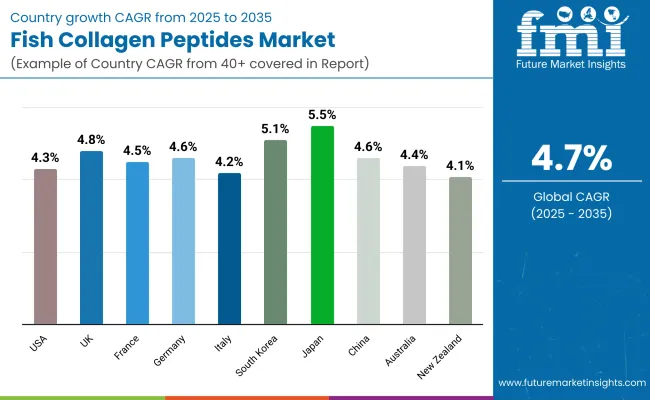
| Countries | CAGR (2025 to 2035) |
|---|---|
| USA | 4.3% |
| UK | 4.8% |
| France | 4.5% |
| Germany | 4.6% |
| Italy | 4.2% |
| South Korea | 5.1% |
| Japan | 5.5% |
| China | 4.6% |
| Australia | 4.4% |
| New Zealand | 4.1% |
The USA industry is expanding at a rapid rate due to the increasing demand for functional foods and nutraceuticals. Since individuals give importance to personal well-being and health, customers are in turn actively seeking out collagen-derived ingredients for uses related to skin care, joint care, and anti-aging. The beauty-from-within trend has gained momentum and is also fueling demand for hydrolyzed collagen peptides as dietary supplements and beverages.
Key industry companies in the USA are focusing on product innovations like fish collagen in protein bars, ready-to-drink products, and skin care supplements. Expansion of e-commerce and direct-to-consumer brands is also contributing to expanding the industry and allowing companies to reach more consumers. Clean-label product trends and regulatory approvals are also increasing consumer confidence and propelling the industry forward. The forecast phase is characterized by the steady growth trend whereby collagen-based products become a staple in the wellness space.
The UK industry is witnessing monumental growth, supported by the progress of product formulation and increasing consumer awareness for preventive healthcare. The industry is supported by a strong demand for sustainably harvested marine collagen, in tandem with the UK's drive towards ethical and sustainable options. High-quality collagen-rich supplements in powder and capsule formats are becoming a common staple in every home as clients integrate them into their daily health regimens.
UK beauty and health firms are leveraging the digital platform to create awareness on the benefits of fish collagen, further driving demand. Investments by private equity firms in health supplement companies have also played a major role in the growth of the business, allowing new entrants to increase their operations and launch new products. As collagen peptides gain more popularity for skin hydration and mobility, the UK industry will experience a consistent growth trend during the forecast period.
France's industry is expanding on the back of robust demand from the cosmetics and pharmaceutical sectors. The country has a natural beauty and skincare culture, which has witnessed collagen peptide-enriched skincare products reach new heights.
French consumers who prefer scientifically supported and quality ingredients are gravitating towards skin and anti-aging wellness through marine-derived collagen peptides. Besides this, the collagen is being integrated into wellness programs by the food and dietary supplement industry, and high-end companies are launching collagen-based nutraceuticals for bone and joint health.
Regulatory updates and increased nutricosmetics trends also support the industry scenario. As France is a hub for luxury wellness and skincare brands, consumption of Fish Collagen Peptides is expected to grow steadily during the forecast period.
The German industry is growing, with intense emphasis on scientific research and functional food development. Clinically documented ingredients are greatly valued among German customers, and therefore fish collagen peptides are gaining increasing use in joint mobility, muscle recovery, and skin suppleness dietary supplements. The sports nutrition segment is also a key driver, with health-aware consumers incorporating collagen-based protein products into their regimen.
The aging population is also a major driver since the aging consumers are seeking osteoporosis remedies and prevention of arthritis. Growth in the German organic and clean-label supplement industry is also responsible for driving industry growth, with firms concentrating on sustainability and transparency. Incorporating marine collagen into fortified beverages and plant-based foods is expected to lead industry penetration in the coming years.
Italian Fish Collagen Peptides is driven by Italy's long history of skincare, wellness, and natural health. The demand for Mediterranean diet-sourced nutraceuticals has driven the industry for marine collagen, particularly from customers looking for overall anti-aging solutions. Italy's cosmetics industry is also leading the charge, with high-end brands adding fish collagen peptides to high-end serums, creams, and ingestible beauty products.
Functional drinks like collagen-fortified coffee and tea are gaining popularity, pushing the industry still further. The well-being tourism sector, responsible for propelling spa therapy and integrative health resorts, is also boosting collagen peptide use, with firms introducing collagen-drenched detox and regeneration packages. The Italian industry will expand at a steady pace due to innovation in luxury wellness and skincare.
South Korean consumers, long renowned for their intense skincare routine, have embraced collagen-fortified products in various categories, including cosmetics, drinks, and supplements. The K-beauty industry is incorporating marine collagen into everything from sheet masks to ingestible ampoules, generating strong demand. South Korea's strong e-commerce industry also offers brands a chance to introduce new collagen-based products in the presence of digitally empowered consumers.
Manufacturers of functional food and beverages are also introducing collagen-fortified beverages, including fruit-flavored collagen shots and probiotic collagen blends, expanding product lines. As South Korea leads global beauty trends, the industry will keep expanding over the next decade.
The industry is led by high penetration levels, and beverages, gummies, and dietary supplements that feature collagen are commonplace. Consumers look for products to have clinical studies, and so the industry has experienced a research-led collagen explosion.
Demographics of aging populations are high, and older individuals are seeking preventive health solutions for joints, skin, and overall health. Japan's nutraceutical industry keeps evolving, incorporating fish collagen into functional foods such as soups, rice, and desserts. Quality and convenience are the major trends propelling the growth of industries, making Japan a global collagen peptide consumer leader.
China's booming e-commerce platforms drive demand for products sourced from collagen, as business houses use online promotion to educate and engage consumers. Marine collagen peptides are popular in the skincare industry, as Chinese consumers actively pursue products providing anti-aging and whitening capabilities for the skin.
Growing demand from the ageing population is the other significant driver, with collagen being increasingly used for bone and joint health healing. Local brands are competing with international brands by launching high-quality local marine collagen products, with the industry becoming highly competitive. The forecast period reflects ongoing growth fueled by consumer awareness and strong internet retailing dynamics.
Australia's market for Fish Collagen Peptides is supported by a robust trend for natural health and sustainability. The consumer is opting for wild-catch fish clean-label collagen, which is in line with the country's focus on sustainability.
There is robust demand within the sports nutrition space that is facing the industry, with athletes and gym members consuming marine collagen to recover muscle and support joint health. Australian health-conscious consumers are also using collagen peptides by taking them through protein powders and beauty drinks. Growing demand for preventive medication and the preference for traceable quality ingredients will drive industry growth for the next decade.
New Zealand's Fish Collagen Peptides industry is also expanding slowly, driven by consumers appreciating health as well as sustainability. The country's lucrative dairy and supplement industries have now started to incorporate marine collagen in new well-being products ranging from protein blends to functional foods.
New Zealand's 'clean and green' image provides a competitive edge to collagen peptides that are locally produced, which resonates with health supplement consumers seeking high-quality premium health supplements. The trend in the industry for sustainability is further supplemented by growing interest in bioavailable types of collagen and plant-based alternatives. With more individuals with experience of the applications of collagen, the industry will continue expanding due to premium product lines and replenish able sources.
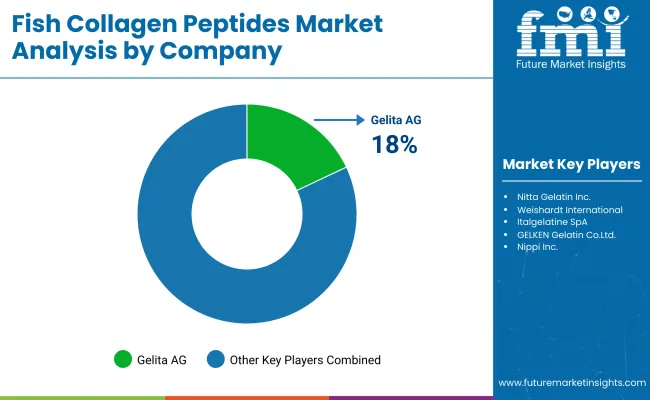
The industry presents a dynamic and competitive scenario due to the presence of established multinational corporations along with regional players. Major manufacturers Gelita AG, Rousselot (Darling Ingredients), and Nitta Gelatin Inc. are leading the charge in the industry while maintaining their monopoly by virtue of a considerable amount of research and development expenses, capacity for large-scale production, and distribution on a good scale.
These players are favorably inclined towards extraction technology improvements to ensure higher collagen purity and bioavailability, mainly servicing the ever-increasing demand from pharmaceutical, nutraceutical, and cosmetic industries. European competitors, Weishardt International and Italgelatine SpA deliver high-quality marine-based collagen peptides and are committed to intense applications. With a strong regional presence and a commitment to product innovation, these players have gained considerable market share in the health and wellness segment.
Companies like Nippi Inc. and GELKEN Gelatin Co., Ltd. play a crucial role in the competitive landscape by offering affordable as well as customizable fish collagen solutions. They tap into the growing consumer base in Asia-Pacific and maintain a slight edge over competition with large-scale production and efficient supply chain management. Hofseth Biocare ASA from Norway builds its competitive advantage on the sustainable utilization of marine by-products as well as the patented processing of high-value, medical-grade collagen peptides.
Market Share Analysis by Company
| Company Name | Estimated Market Share (%) |
|---|---|
| Gelita AG | 18-22% |
| Rousselot (Darling Ingredients) | 15-19% |
| Nitta Gelatin Inc. | 12-16% |
| Weishardt International | 8-12% |
| Italgelatine SpA | 7-11% |
| Other Companies (Combined) | 30-40% |
| Company Name | Key Offerings/Activities |
|---|---|
| Gelita AG | Develops VERISOL bioactive collagen peptides for skin as well as joint health, focusing on high-purity marine collagen. |
| Rousselot (Darling Ingredients) | Offers Peptan fish collagen, widely used in beauty and wellness applications, supported by clinical research. |
| Nitta Gelatin Inc. | It specializes in wellness-focused collagen peptides as well as supplies them to the nutraceutical, pharmaceutical, and food industries. |
| Weishardt International | Produces Naticol marine collagen, known for its high bioavailability and scientifically validated benefits. |
| Italgelatine SpA | It focuses on premium-grade fish collagen for cosmetics as well as functional foods, with an emphasis on sustainability. |
Key Company Insights
Gelita AG (18-22%)
Gelita dominates the industry with its VERISOLmarine collagen peptides, supported by clinical evidence demonstrating benefits for skin elasticity, wrinkle reduction, and joint health. The firm invests in enzymatic hydrolysis technologies to maximize collagen absorption.
Rousselot (Darling Ingredients) (15-19%)
Rousselot's Peptan fish collagen is a well-known international brand in nutrition and sports nutrition. The firm partners with cosmetic as well as nutraceutical companies to drive innovation in anti-aging solutions.
Nitta Gelatin Inc. (12-16%)
Nitta Gelatin is a dominant supplier to the functional food and pharmaceutical sectors, with a good presence in North America and Japan. Its Wellnex collagen peptides target joint wellness, sports nutrition, and cosmetics industries.
Weishardt International (8-12%)
Weishardt has competitive advantages through Naticol collagen peptides, which are known for high bioavailability and European quality standards. It is actively engaged in clinical studies and responsible sourcing.
Italgelatine SpA (7-11%)
Italgelatine is a European market-leading collagen manufacturer with expertise in cosmetics and premium dietary supplements. It is dedicated to sustainable marine collagen production with a focus on traceability as well as sustainable sourcing.
Other Key Players (30-40% Combined)
By source, the industry is segmented into Fins, Skin, Scales, and Bones.
By application, the segmentation includes Nutraceuticals, Food & Beverages, Agriculture, Cosmetics, Animal Nutrition, and Pharmaceuticals.
By region, the industry analysis covers North America, Latin America, Western Europe, Eastern Europe, East Asia, South Asia & Pacific, Central Asia, Russia & Belarus, Balkan & Baltic Countries, and the Middle East & Africa.
The industry is expected to reach USD 855.8 million in 2025.
The industry is projected to grow to USD 1.35 billion by 2035.
The industry is expected to grow at a CAGR of 4.7% from 2025 to 2035.
Japan is expected to grow at the fastest rate, with a CAGR of 5.5% during the forecast period.
The skin segment is among the most widely used in the industry.
Leading companies include Gelita AG, GELKEN Gelatin Co., Ltd., Rousselot (Darling Ingredients), Nitta Gelatin Inc., Italgelatine SpA, Weishardt International, Nippi Inc., Titan Biotech Limited, Holista Colltech Ltd., Vital Proteins LLC, and Z Natural.






Full Research Suite comprises of:
Market outlook & trends analysis
Interviews & case studies
Strategic recommendations
Vendor profiles & capabilities analysis
5-year forecasts
8 regions and 60+ country-level data splits
Market segment data splits
12 months of continuous data updates
DELIVERED AS:
PDF EXCEL ONLINE
Fish Pond Circulating Water Pump Filter Market Size and Share Forecast Outlook 2025 to 2035
Fish Hydrolysate Market Size and Share Forecast Outlook 2025 to 2035
Fish Protein Isolates Market Size and Share Forecast Outlook 2025 to 2035
Fish Meal Alternative Market Size and Share Forecast Outlook 2025 to 2035
Fish Oil Alternatives Market Size and Share Forecast Outlook 2025 to 2035
Fish Protein Concentrate Market Size and Share Forecast Outlook 2025 to 2035
Fish Feed Pellet Making Machine Market Size and Share Forecast Outlook 2025 to 2035
Fish Fermentation Market Size and Share Forecast Outlook 2025 to 2035
Fishing Reels Market Analysis - Size, Share, and Forecast Outlook 2025 to 2035
Fish Filleting Machine Market Size and Share Forecast Outlook 2025 to 2035
Fish Deboning Machine Market Size and Share Forecast Outlook 2025 to 2035
Fish Cutting Machine Market Size and Share Forecast Outlook 2025 to 2035
Fish Processing Equipment Market Size and Share Forecast Outlook 2025 to 2035
Fish Protein Hydrolysate Market Size and Share Forecast Outlook 2025 to 2035
Fish Protein Hydrolysate For Animal Feed And Pet Food Applications Market Size and Share Forecast Outlook 2025 to 2035
Fishmeal and Fish Oil Market Analysis - Size, Share, and Forecast Outlook 2025 to 2035
Fish Feed Ingredients Market Analysis - Size, Share, and Forecast Outlook 2025 to 2035
Fish Bone Minerals Market Analysis - Size, Share, and Forecast Outlook 2025 to 2035
Fish Peptones Market Size, Growth, and Forecast for 2025 to 2035
Fish Nutrition Market Size, Growth, and Forecast for 2025 to 2035

Thank you!
You will receive an email from our Business Development Manager. Please be sure to check your SPAM/JUNK folder too.
Chat With
MaRIA